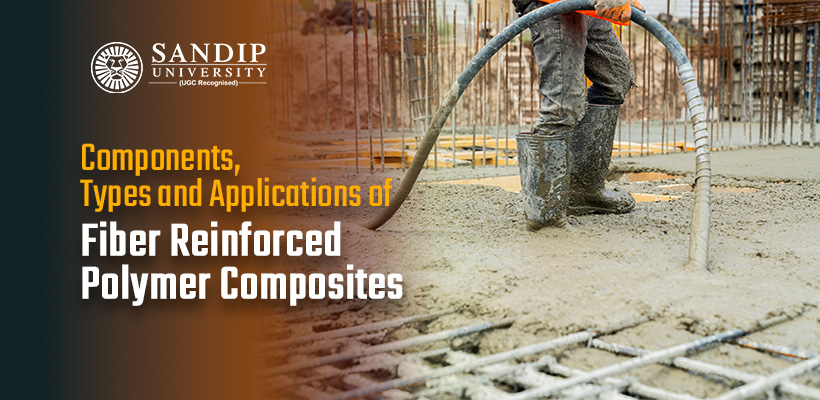Fiber reinforced polymer (FRP) composites are a class of materials composed of a polymer matrix reinforced with fibers. These materials have gained significant attention and utility across various industries due to their exceptional mechanical properties, lightweight nature, corrosion resistance, and versatility in design and application. Many top engineering colleges in Maharashtra include the study of fiber composite polymer in the course curriculum to help students understand the concept.
Let us take a look at the components, types, manufacturing process, and applications of fiber reinforced polymer composites.
- Components
- Polymer Matrix: A polymer matrix refers to the continuous phase in a composite material where the polymer acts as the binding substance that holds together various reinforcing materials, such as fibers or particles. In these composites, the polymer matrix provides structural integrity, distribution of loads, and protection to the reinforcing components. The matrix material in FRP composites is typically a polymer such as epoxy, polyester, vinyl ester, or thermoplastic resins.
- Reinforcing Fibers: Reinforcing fibers are materials incorporated into a polymer matrix to enhance the mechanical properties of composites. These fibers provide strength, stiffness, and sometimes other specific attributes to the composite material. Fibers such as carbon, glass, aramid (such as Kevlar), or natural fibers like bamboo or hemp are commonly used as reinforcement.
- Types of Fibers
- Carbon Fiber: Carbon fibers are known for its exceptional strength, stiffness, and lightweight properties. Carbon fiber is extensively used in high-performance applications such as aerospace, automotive, and sports equipment.
- Glass Fibers: Glass fibers are more affordable than carbon fibers and offer good strength and stiffness properties. They are commonly used in applications where cost-effectiveness and corrosion resistance are important.
- Aramid Fiber: Aramid fibers, such as Kevlar, possess high strength-to-weight ratios and excellent resistance to impact and abrasion. They find applications in ballistic protection, aerospace, and sporting goods.
- Natural Fibers: Natural fibers like bamboo, hemp, or flax are renewable and environmentally friendly alternatives. They are used in applications where biodegradability or aesthetics are priorities.
- Manufacturing Processes:
- Hand Lay-up: It involves manually laying the reinforcing fibers onto a mold and saturating them with the polymer resin.
Advantages: Flexibility, low cost, ease of modification, suitability for large parts.
limitations: labor intensive, quality consistency, environmental considerations.
- Filament Winding: In this process, continuous fibers are wound onto a rotating mandrel in a specific pattern and impregnated with resin to form a hollow structure. Here’s a breakdown of the process: (1) Mandrel preparation, (2) Filament selection, (3) Resin application, (4) Winding process, (5) Curing and (6) Mandrel removal.
Advantages: Tailored properties, design flexibility, corrosion resistance, durability and fatigue resistance, temperature resistance, cost efficiency.
Limitations: Complexity and skill, limited geometries, high equipment cost, quality control, curing constraints.
- Pultrusion: A continuous process where reinforcing fibers are pulled through a resin bath, then shaped and cured in a heated die to produce profiles with constant cross-sections.
Advantages: Consistency and precision, high strength-to-weight ratio, corrosion resistance, continuous production, reduced labor costs, low material waste, customization.
Limitations: Limited to linear shape, design constraints, thermal management, tooling and die costs, initial setup costs, material limitations, post-processing needs.
- Compression Molding: Reinforcing fibers are pre-impregnated with resin and placed into a mold, then subjected to heat and pressure to cure the composite material.
Advantages: Ability to mold complex shapes, cost-effective for large volume, material efficiency, low tooling costs, good surface finish, variety of materials.
Limitations: Material constraints, manual labor, surface defects, long cycle times, initial tooling costs, limited part size.
- Applications:
- Aerospace: FRP composites are used in aircraft components such as fuselages, wings, and interior structures due to their high strength-to-weight ratio and fatigue resistance.
- Automotive: FRP components are increasingly used in automotive manufacturing to reduce vehicle weight, improve fuel efficiency, and enhance crashworthiness.
- Construction: FRP composites are employed in infrastructure projects for bridge decks, reinforcement of concrete structures, and seismic retrofitting due to their corrosion resistance and durability.
- Sports and Recreation: From tennis rackets to bicycles, FRP components are widely utilized in sports goods for their lightweight, high strength properties.
- Marine: FRP composites are used in boat hulls, decks, and other marine applications due to their resistance to saltwater corrosion.
Conclusion
Fiber reinforced polymer composites offer a compelling combination of mechanical performance, lightweight design, and versatility, making them invaluable materials across a diverse range of industries and applications. FRP composites are transforming various industries by offering a combination of strength, durability, and flexibility that is difficult to achieve with traditional materials. This is why some of the best engineering colleges in Nashik focus on the study of FRP composites to drive advancements in diverse fields. As technology advances, their applications and performance continue to evolve, making them a key material in modern engineering and design.

